Overview
- Brief Narrative
- Set of 3 pins with the insignia of the 26th Infantry Regiment, US Army, acquired by 19 year old David C. Porter during his service in the US Army in Germany from 1945 to 1946. The pins were worn in pairs, with the third a spare, on the lapels of dress uniform jackets in order to distinguish different regiments. David was deployed in February 1945 to join troops of the 102nd Infantry Division in combat in Germany. By the end of the war in May, David was a mortar crew chief for Company A, 26th Infantry Regiment. David and other members of the 102nd were selected to serve as guards for the International Military Tribunal at Nuremberg. Its purpose was to seek justice for crimes against humanity, evidenced by the Holocaust, perpetrated by Nazi Germany. David was assigned to guard prisoners being prosecuted during the Trial of Major German War Criminals for crimes against peace, war crimes, crimes against humanity, and conspiracy to commit these crimes. David was promoted to Sergeant in September. He guarded the defendants in their cells and then was assigned to stand guard in the courtroom during the proceedings. David returned to the US and was honorably discharged in July 1946. The trial lasted from November 1945 to August 1946. Verdicts were delivered on October 1, 1946: twelve defendants were sentenced to death; three to life imprisonment; four to prison terms ranging from 10-20 years; three were acquitted.
- Date
-
received:
1945-1946
- Geography
-
acquired:
Germany
- Credit Line
- United States Holocaust Memorial Museum Collection, Gift of Ethel P. Kemmerer
- Contributor
-
Subject:
David C. Porter
- Biography
-
David C. Porter (1926-2010) was born in Abington, Pennsylvania. He was the second of seven children born to Mary C. and William J. Porter. His parents were both born in Pennsylvania, and married in 1921. William worked as an iron clerk, and Mary was a secretary at a construction company.
Soon after the December 7, 1941, attack on Pearl Harbor, the United States entered World War II. In spring 1944, David completed high school. On September 11, he enlisted in the US Army and was assigned to the 102nd Combat Infantry Division, nicknamed the Ozarks Division. He was deployed to Germany in February 1945 and advanced with his unit through central Europe to the Rhineland and then toward Berlin. David rose to the position of mortar crew chief for Company A, 26th Infantry Regiment. On April 15, the Division was placed on patrol along the Elbe River. On May 7, 1945, Germany surrendered. The 102nd was placed on occupational duty in Gotha, Germany.
In August 1945, the United Nations War Crimes Commission authorized a military tribunal to be convened by eighteen Allied Nations, and conducted by the four major powers, the United States, Great Britain, France, and the Soviet Union in Nuremberg, Germany. The purpose of the International Military Tribunal was to seek justice for crimes against humanity, evidenced by the Holocaust, perpetrated by Nazi Germany. Twenty-four defendants were indicted in October 1945 for the first trial, the Major German War Criminals trial. There were four counts: crimes against peace, war crimes, crimes against humanity, and conspiracy to commit these crimes. The trial began on November 20, 1945. The verdicts were delivered on October 1, 1946: twelve defendants were sentenced to death; three to life imprisonment; four to prison terms ranging from 10-20 years; three were acquitted.
The 1st Infantry was assigned the task of guarding the defendants. There were three types of guards: Special, Regular and Prison. Initially, David was responsible for guarding defendants in their cells. Cell guards were equipped with white helmet liners and nightsticks. David received his promotion to Sergeant on September 5. In late December, David was promoted to Special escort and court guard and was assigned to stand guard behind the prisoners in the courtroom in the Palace of Justice. Other duties included escorting the defendants to and from their cells in the morning and evening, and transporting evidence. The guards supervised the lunches, where the defendants were separated into four groups of five, with Goring eating alone. In early July 1946, David returned to the US and was honorably discharged on July 29.
David returned to Pennsylvania and worked as a comptroller at a manufacturing company. He married Violet Andrews and the couple had one child. David regularly presented lectures about his experiences as a guard during the Nuremberg War Crimes Trials.
Physical Details
- Classification
-
Military Insignia
- Category
-
Badges
- Object Type
-
Lapel pins (aat)
- Physical Description
- a. Shield shaped, shiny gold colored, pressed metal pin with a double scalloped 3 pointed top edge, curved sides that taper to a bottom point, and a raised gold border. The enameled front has an upward pointing blue arrowhead outlined in gold and centered on a white field. A bronze colored metal screw back clasp is soldered to the back. Some paint is missing from a scratch on the left front.
b. Shield shaped, shiny gold colored, pressed metal pin with a double scalloped, 3 pointed top edge, curved sides that taper to a bottom point, and a raised gold border. The enameled front has an upward pointing blue arrowhead outlined in gold and centered on a white field. A bronze colored metal screw back clasp is soldered to the back. Some paint is missing from a scratch on the arrowhead.
c. Shield shaped, shiny gold colored, pressed metal pin with a double scalloped, 3 pointed top edge, curved sides that taper to a bottom point, and a raised gold border. The enameled front has an upward pointing blue arrowhead outlined in gold and centered on a white field. A bronze colored metal screw back clasp is soldered to the back. - Dimensions
- a: Height: 1.125 inches (2.858 cm) | Width: 1.000 inches (2.54 cm) | Depth: 0.375 inches (0.953 cm)
b: Height: 1.125 inches (2.858 cm) | Width: 1.000 inches (2.54 cm) | Depth: 0.375 inches (0.953 cm)
c: Height: 1.125 inches (2.858 cm) | Width: 1.000 inches (2.54 cm) | Depth: 0.375 inches (0.953 cm) - Materials
- a : metal, enamel paint
b : metal, enamel paint
c : metal, enamel paint
Rights & Restrictions
- Conditions on Access
- No restrictions on access
- Conditions on Use
- No restrictions on use
Keywords & Subjects
Administrative Notes
- Legal Status
- Permanent Collection
- Provenance
- The pins were donated to the United States Holocaust Memorial Museum in 2011 by Ethel P. Kemmerer, the sister of David C. Porter and executor of his Estate.
- Funding Note
- The cataloging of this artifact has been supported by a grant from the Conference on Jewish Material Claims Against Germany.
- Record last modified:
- 2022-07-28 20:14:03
- This page:
- https://collections.ushmm.org/search/catalog/irn44008
Download & Licensing
In-Person Research
- By Appointment
- Request 21 Days in Advance of Visit
- Plan a Research Visit
- Request to See This Object
Contact Us
Also in David C. Porter collection
The collection consists of patches, pins, dog tags, a medal, boxes, documents, and photographs relating to the experiences of David C. Porter in the United States Army in Germany during World War II and after the war as a guard during the International Military Tribunal proceedings held in Nuremberg, Germany.
Date: 1936-2010
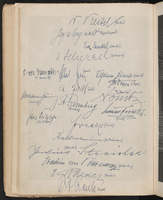
David C. Porter papers
Document
The David C. Porter papers include military records, photographs, news clippings, and speech notes documenting Porter's experiences as a member of the United States Army during World War II and as a guard at the International Military Tribunal at Nuremberg from 1945-1946. The papers also include a 1946 photograph book, Nurnberg, which includes signatures of tribunal defendants, prosecution and defense staff, translators, press corps (including Betsy and Walter Cronkite), and the guard staff.
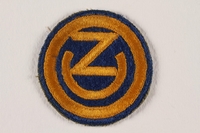
US Army 102nd Infantry Division shoulder sleeve patch with OZ worn by a soldier
Object
Shoulder sleeve badge, 102nd Infantry Division, known as the Ozarks Division, worn by 19 year old David C. Porter during his service as a soldier in the US Army in Germany from February 1945 to July 1946. David was deployed in February 1945 to join troops of the 102nd Infantry Division in combat in Germany. By the end of the war in May, David was a mortar crew chief for Company A, 26th Infantry Regiment. David and other members of the 102nd were selected to serve as guards for the International Military Tribunal at Nuremberg. Its purpose was to seek justice for crimes against humanity, evidenced by the Holocaust, perpetrated by Nazi Germany. David was assigned to guard prisoners being prosecuted during the Trial of Major German War Criminals for crimes against peace, war crimes, crimes against humanity, and conspiracy to commit these crimes. David was promoted to Sergeant in September. He guarded the defendants in their cells and then was assigned to stand guard in the courtroom during the proceedings. David returned to the US and was honorably discharged in July 1946. The trial lasted from November 1945 to August 1946. Verdicts were delivered on October 1, 1946: twelve defendants were sentenced to death; three to life imprisonment; four to prison terms ranging from 10-20 years; three were acquitted.
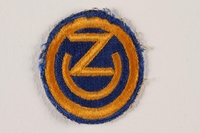
US Army 102nd Infantry Division shoulder sleeve patch with OZ worn by a soldier
Object
Shoulder sleeve badge, 102nd Infantry Division, known as the Ozarks Division, worn by 19 year old David C. Porter while a soldier in the US Army in Germany from February 1945 to July 1946. David deployed in February 1945 joining the 102nd Infantry in combat in Germany. By the end of the war in May, David was a mortar crew chief for Company A, 26th Infantry Regiment. David and others of the 102nd were selected to serve as guards for the International Military Tribunal at Nuremberg. David was assigned to guard prisoners during the Trial of Major German War Criminals. He guarded defendants in their cells and then was assigned to stand guard in the courtroom during the proceedings. David returned to the US and was honorably discharged in July 1946. The trial lasted from November 1945 to August 1946. Verdicts were delivered on October 1, 1946: twelve defendants were sentenced to death; three to life imprisonment; four to prison terms ranging from 10-20 years; three were acquitted.
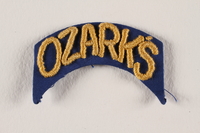
US Army 102nd Infantry Division arched Ozark's patch worn by a soldier
Object
102nd Infantry Division, Ozark's badge, worn by 19 year old David C. Porter while a soldier in the US Army in Germany from February 1945 to July 1946. David deployed in February 1945 joining the 102nd Infantry in combat in Germany. By the end of the war in May, David was a mortar crew chief for Company A, 26th Infantry Regiment. David and others of the 102nd were selected to serve as guards for the International Military Tribunal at Nuremberg. David was assigned to guard prisoners during the Trial of Major German War Criminals. He guarded defendants in their cells and then was assigned to stand guard in the courtroom during the proceedings. David returned to the US and was honorably discharged in July 1946. The trial lasted from November 1945 to August 1946. Verdicts were delivered on October 1, 1946: twelve defendants were sentenced to death; three to life imprisonment; four to prison terms ranging from 10-20 years; three were acquitted.
![Pair of blue and silver collar tabs for a Luftwaffe Hauptmann [Captain] acquired by a US soldier Pair of blue and silver collar tabs for a Luftwaffe Hauptmann [Captain] acquired by a US soldier](https://www.ushmm.org/media/emu/get?irn=43398&mm_irn=15013&file=secondary)
Pair of blue and silver collar tabs for a Luftwaffe Hauptmann [Captain] acquired by a US soldier
Object
Two collar badges with birds and oak leaves from a Luftwaffe Hauptmann's uniform acquired by 19 year old David C. Porter during his service as a soldier in the US Army in Germany from February 1945 to July 1946. The tabs would have been worn in pairs on the collar points of a uniform shirt or jacket to distinguish military branch and rank. David deployed in February 1945 to join the 102nd Infantry Division in combat in Germany. By the end of the war in May, he was a mortar crew chief for Company A, 26th Infantry Regiment. David and others of the 102nd were selected to serve as guards for the International Military Tribunal at Nuremberg. David was assigned to guard prisoners during the Trial of Major German War Criminals. He guarded defendants in their cells and then was assigned to stand guard in the courtroom during the proceedings. David returned to the US and was honorably discharged in July 1946. The trial lasted from November 1945 to August 1946. Verdicts were delivered on October 1, 1946: twelve defendants were sentenced to death; three to life imprisonment; four to prison terms ranging from 10-20 years; three were acquitted.
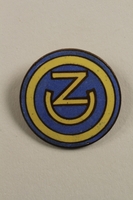
US Army 102nd Infantry Division enameled lapel pin with OZ worn by a soldier
Object
Lapel pin insignia of the 102nd Infantry Division, known as the Ozarks Division, worn by 19 year old David C. Porter while a soldier in the US Army in Germany from February 1945 to July 1946. David deployed in February 1945 joining the 102nd Infantry in combat in Germany. By the end of the war in May, David was a mortar crew chief for Company A, 26th Infantry Regiment. David and others of the 102nd were selected to serve as guards for the International Military Tribunal at Nuremberg. David was assigned to guard prisoners during the Trial of Major German War Criminals. He guarded defendants in their cells and then was assigned to stand guard in the courtroom during the proceedings. David returned to the US and was honorably discharged in July 1946. The trial lasted from November 1945 to August 1946. Verdicts were delivered on October 1, 1946: twelve defendants were sentenced to death; three to life imprisonment; four to prison terms ranging from 10-20 years; three were acquitted.
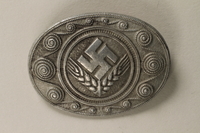
Women’s Reich Labor Service commemorative pin acquired by a US soldier
Object
Reichsarbeitsdienst der weiblichen Jugend [Women’s Reich Labor Service] scarf pin acquired by 19 year old David C. Porter during his service in the US Army in Germany from February 1945 to July 1946. Beginning in 1938, the Reichsarbeitsdienst provided auxiliary support to the German military. Young women received a commemorative brooch upon the completion of their service period. David was deployed in February 1945 to join troops of the 102nd Infantry Division in combat in Germany. By the end of the war in May, David was a mortar crew chief for Company A, 26th Infantry Regiment. David and other members of the 102nd were selected to serve as guards for the International Military Tribunal at Nuremberg. Its purpose was to seek justice for crimes against humanity, evidenced by the Holocaust, perpetrated by Nazi Germany. David was assigned to guard prisoners being prosecuted during the Trial of Major German War Criminals for crimes against peace, war crimes, crimes against humanity, and conspiracy to commit these crimes. David was promoted to Sergeant in September. He guarded the defendants in their cells and then was assigned to stand guard in the courtroom during the proceedings. David returned to the US and was honorably discharged in July 1946. The trial lasted from November 1945 to August 1946. Verdicts were delivered on October 1, 1946: twelve defendants were sentenced to death; three to life imprisonment; four to prison terms ranging from 10-20 years; three were acquitted.
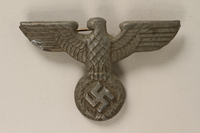
Pressed tin cap badge of a Reichsadler acquired by a US soldier
Object
German cap badge of a Reichsadler, an Imperial eagle holding a swastika, acquired by 19 year old David C. Porter during his service as a soldier in the US Army in Germany from February 1945 to July 1946. David was deployed in February 1945 to join troops of the 102nd Infantry Division in combat in Germany. By the end of the war in May, David was a mortar crew chief for Company A, 26th Infantry Regiment. David and other members of the 102nd were selected to serve as guards for the International Military Tribunal at Nuremberg. Its purpose was to seek justice for crimes against humanity, evidenced by the Holocaust, perpetrated by Nazi Germany. David was assigned to guard prisoners being prosecuted during the Trial of Major German War Criminals for crimes against peace, war crimes, crimes against humanity, and conspiracy to commit these crimes. David was promoted to Sergeant in September. He guarded the defendants in their cells and then was assigned to stand guard in the courtroom during the proceedings. David returned to the US and was honorably discharged in July 1946. The trial lasted from November 1945 to August 1946. Verdicts were delivered on October 1, 1946: twelve defendants were sentenced to death; three to life imprisonment; four to prison terms ranging from 10-20 years; three were acquitted.
![Hitlerjugend [Hitler Youth] enamel membership pin acquired by a US soldier Hitlerjugend [Hitler Youth] enamel membership pin acquired by a US soldier](https://www.ushmm.org/media/emu/get?irn=43403&mm_irn=17556&file=secondary)
Hitlerjugend [Hitler Youth] enamel membership pin acquired by a US soldier
Object
Hitlerjugend [Hitler Youth] membership pin acquired by 19 year old David C. Porter during his service in the US Army in Germany from February 1945 to July 1946. The Hitler Youth was founded by the Nazi Party in 1926 to shape ideological beliefs of German youth. In 1936, membership became mandatory for all children between the ages of ten and seventeen. David was deployed in February 1945 to join troops of the 102nd Infantry Division in combat in Germany. By the end of the war in May, David was a mortar crew chief for Company A, 26th Infantry Regiment. David and other members of the 102nd were selected to serve as guards for the International Military Tribunal at Nuremberg. Its purpose was to seek justice for crimes against humanity, evidenced by the Holocaust, perpetrated by Nazi Germany. David was assigned to guard prisoners being prosecuted during the Trial of Major German War Criminals for crimes against peace, war crimes, crimes against humanity, and conspiracy to commit these crimes. David was promoted to Sergeant in September. He guarded the defendants in their cells and then was assigned to stand guard in the courtroom during the proceedings. David returned to the US and was honorably discharged in July 1946. The trial lasted from November 1945 to August 1946. Verdicts were delivered on October 1, 1946: twelve defendants were sentenced to death; three to life imprisonment; four to prison terms ranging from 10-20 years; three were acquitted.
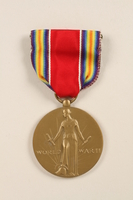
World War II Victory Medal with ribbon and box awarded to a US soldier
Object
World War II Victory Medal and box awarded to David C. Porter, who served in the US Army in Germany from February 1945 to July 1946. The campaign medal was issued to Armed Forces members who served at least one day of honorable, active service between December 7, 1941, and December 31, 1946. David, 18, was deployed in February 1945 to join troops of the 102nd Infantry Division in combat in Germany. By the end of the war in May, David was a mortar crew chief for Company A, 26th Infantry Regiment. David and other members of the 102nd were selected to serve as guards for the International Military Tribunal at Nuremberg. Its purpose was to seek justice for crimes against humanity, evidenced by the Holocaust, perpetrated by Nazi Germany. David was assigned to guard prisoners being prosecuted during the Trial of Major German War Criminals for crimes against peace, war crimes, crimes against humanity, and conspiracy to commit these crimes. David was promoted to Sergeant in September. He guarded the defendants in their cells and then was assigned to stand guard in the courtroom during the proceedings. David returned to the US and was honorably discharged in July 1946. The trial lasted from November 1945 to August 1946. Verdicts were delivered on October 1, 1946: twelve defendants were sentenced to death; three to life imprisonment; four to prison terms ranging from 10-20 years; three were acquitted.
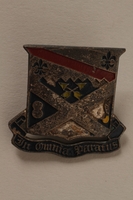
Set of US Army 18th Infantry Regiment lapel pins acquired by a US soldier
Object
Set of 3 lapel pins with the insignia of the 18th Infantry Regiment, US Army, acquired by 19 year old David C. Porter during his service in the US Army in Germany from February 1945 to July 1946. The pins were worn in pairs, with the third as a spare, on the lapels of dress uniform jackets to distinguish different regiments. David was deployed in February 1945 to join troops of the 102nd Infantry Division in combat in Germany. By the end of the war in May, David was a mortar crew chief for Company A, 26th Infantry Regiment. David and other members of the 102nd were selected to serve as guards for the International Military Tribunal at Nuremberg. Its purpose was to seek justice for crimes against humanity, evidenced by the Holocaust, perpetrated by Nazi Germany. David was assigned to guard prisoners being prosecuted during the Trial of Major German War Criminals for crimes against peace, war crimes, crimes against humanity, and conspiracy to commit these crimes. David was promoted to Sergeant in September. He guarded the defendants in their cells and then was assigned to stand guard in the courtroom during the proceedings. David returned to the US and was honorably discharged in July 1946. The trial lasted from November 1945 to August 1946. Verdicts were delivered on October 1, 1946: twelve defendants were sentenced to death; three to life imprisonment; four to prison terms ranging from 10-20 years; three were acquitted.
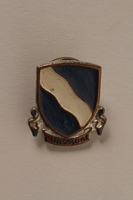
Set of US Army 405th Infantry Regiment lapel pins acquired by a US soldier
Object
Set of 3 lapel pins with the insignia of the 405th Infantry Regiment, US Army, acquired by 19 year old David C. Porter during his service in the US Army in Germany from February 1945 to July 1946. The pins were worn in pairs, with the third a spare, on the lapels of dress uniform jackets to distinguish different regiments. David was deployed in February 1945 to join troops of the 102nd Infantry Division in combat in Germany. By the end of the war in May, David was a mortar crew chief for Company A, 26th Infantry Regiment. David and other members of the 102nd were selected to serve as guards for the International Military Tribunal at Nuremberg. Its purpose was to seek justice for crimes against humanity, evidenced by the Holocaust, perpetrated by Nazi Germany. David was assigned to guard prisoners being prosecuted during the Trial of Major German War Criminals for crimes against peace, war crimes, crimes against humanity, and conspiracy to commit these crimes. David was promoted to Sergeant in September. He guarded the defendants in their cells and then was assigned to stand guard in the courtroom during the proceedings. David returned to the US and was honorably discharged in July 1946. The trial lasted from November 1945 to August 1946. Verdicts were delivered on October 1, 1946: twelve defendants were sentenced to death; three to life imprisonment; four to prison terms ranging from 10-20 years; three were acquitted.
Set of US Army issue dog tags worn by a soldier in the 102nd Infantry Division
Object
Pair of US Army issue dog tags worn by 19 year old David C. Porter during his service as a soldier in the US Army in Germany from February 1945 to July 1946. David was deployed in February 1945 to join troops of the 102nd Infantry Division in combat in Germany. By the end of the war in May, David was a mortar crew chief for Company A, 26th Infantry Regiment. David and other members of the 102nd were selected to serve as guards for the International Military Tribunal at Nuremberg. Its purpose was to seek justice for crimes against humanity, evidenced by the Holocaust, perpetrated by Nazi Germany. David was assigned to guard prisoners being prosecuted during the Trial of Major German War Criminals for crimes against peace, war crimes, crimes against humanity, and conspiracy to commit these crimes. David was promoted to Sergeant in September. He guarded the defendants in their cells and then was assigned to stand guard in the courtroom during the proceedings. David returned to the US and was honorably discharged in July 1946. The trial lasted from November 1945 to August 1946. Verdicts were delivered on October 1, 1946: twelve defendants were sentenced to death; three to life imprisonment; four to prison terms ranging from 10-20 years; three were acquitted.
Plastic cigarette case with the 102nd Infantry insignia and Bavaria used by a US soldier
Object
Marbled offwhite plastic cigarette case, with the embossed insignia of the 102nd Infantry Division and Bavaria 1945, used by 19 year old David C. Porter to hold his dog tags during his service in the US Army in Germany from 1945 to 1946. Commemorative cigarette boxes were carried by soldiers who served as guards during the International Military Tribunal proceedings. David was deployed in February 1945 to join troops of the 102nd Infantry Division in combat in Germany. By the end of the war in May, David was a mortar crew chief for Company A, 26th Infantry Regiment. David and other members of the 102nd were selected to serve as guards for the International Military Tribunal at Nuremberg. Its purpose was to seek justice for crimes against humanity, evidenced by the Holocaust, perpetrated by Nazi Germany. David was assigned to guard prisoners being prosecuted during the Trial of Major German War Criminals for crimes against peace, war crimes, crimes against humanity, and conspiracy to commit these crimes. David was promoted to Sergeant in September. He guarded the defendants in their cells and then was assigned to stand guard in the courtroom during the proceedings. David returned to the US and was honorably discharged in July 1946. The trial lasted from November 1945 to August 1946. Verdicts were delivered on October 1, 1946: twelve defendants were sentenced to death; three to life imprisonment; four to prison terms ranging from 10-20 years; three were acquitted.



